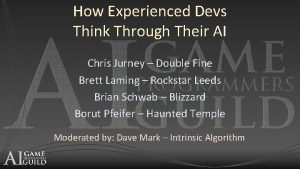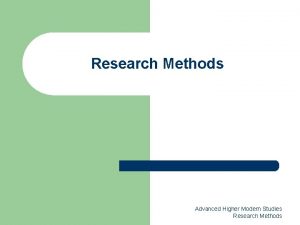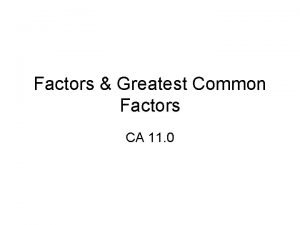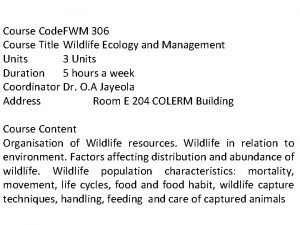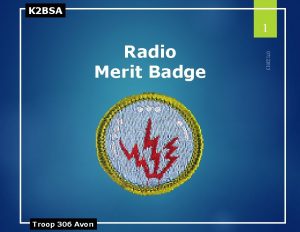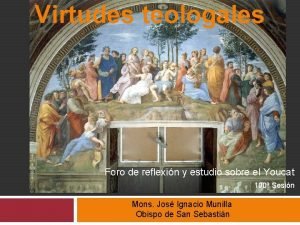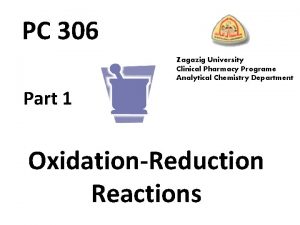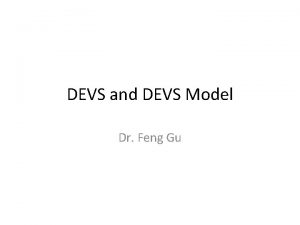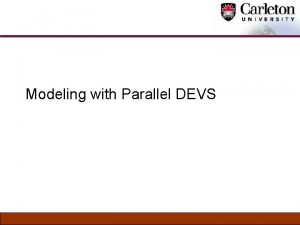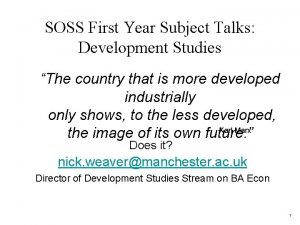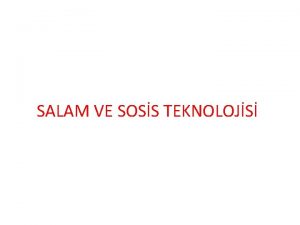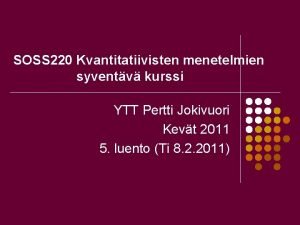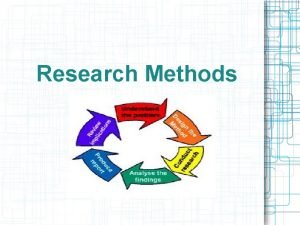ADVANCED RESEARCH METHODS DEVS 306 SOSS 235MCPS 190











- Slides: 11

ADVANCED RESEARCH METHODS DEVS 306 (SOSS 235/MCPS 190) Introduction

THE PURPOSE OF THE COURSE v. Students will gain a theoretical and practical understanding of - qualitative interviews, - participant and non-participant observation, - content analysis, - discourse analysis and - visual presentation of data.

COURSE SCHEDULE AND CONTENTS v. Tue 15. 3 Introduction (Viveca 416, 12: 15 -16: 00) v. Wed 16. 3. Lecture: Qualitative interviews, field observation and ethnographic analysis (Viveca 416, 12: 15 -16: 00) v. Thu 17. 3. Lecture: Qualitative interviews, field observation and ethnographic analysis (Viveca 416, 12: 15 -16: 00) v. Tue 29. 3. Group presentations on interviews and observations (Viveca 416, 12: 15 -16: 00) v. Wed 30. 3. Lecture: Text analyses of the media and policy document data (Viveca 416, 12: 15 -16: 00)

COURSE SCHEDULE AND CONTENTS v. Thu 31. 3. Lecture: Text analyses of the media and policy document data (Viveca 416, 12: 15 -16: 00) v. Wed 6. 4. Group presentations on text analyses (Viveca 416, 12: 15 -16: 00) v. Wed 13. 4. Lecture: Tables and graphs (Viveca 416, 12: 1516: 00) v. Thu 14. 4. Lecture: Tables and graphs (Viveca 416, 12: 1516: 00) v. Wed 20. 4. Group presentations on tables and graphs (Viveca 416, 12: 15 -16: 00) v. Thu 21. 4. Learning café and feedback (Lyhty, 14: 15 -16: 00)

MODES OF COMPLETION v. Compulsory attendance in all sessions v. Theme interviews in pairs: -Contact the interviewee and agree about the interview time. -Prepare a short interview form with 5 -7 questions. -Do the interview and record/video it. -Transcribe interviews and submit them to Lalli -Prepare a presentation on the basis of your interviews: interview situation (who, where, when, challenges/successes); reflections on methodological strategy and technique; a summary of your findings; reflections on the quality and credibility of your data. * The contact details of possible interviewees will be available on 1 st lecture.

MODES OF COMPLETION v An observation exercise: -Choose a place, event or situation you want to observe. -Make a research question(s): what do you want to observe? -Record/video and/or make notes. -Transcribe a field diary and submit it to Lalli. -Prepare a presentation on the basis of your observations: the situation (who, where, when, challenges/successes); reflections on methodological strategy and technique; a summary of your findings; reflections on the quality and credibility of your data – did you find answers to your questions.

MODES OF COMPLETION v. Text analyses workshop: - Newspaper analysis: Read given articles and do (a) a critical discourse analysis or (b) a rhetorical discourse analysis to them. Guiding questions: 1) How are different discourses, meanings and subject-positions constructed and put into an hierarchical order in texts through using certain vocabularies, rhetoric means and ways of convincing. 2) How do rhetorics and discourses connect to power and sociocultural practices. -Document analysis: Read a given document and do (a) a critical/Foucauldian discourse analysis or (b) a theoretical content analysis to it. Guiding question: 1) How are different discourses, meanings and subject-positions constructed and put into an hierarchical order in texts 2) How are institutionalized power positions used and constructed in the text. 3) What are the key themes and meanings given to the core issues in them? * The documents and media material will be available on the 1 st lecture

MODES OF COMPLETION v. Tables and graphs workshop: - Choose the topic you want to analyze from the database - Create tables and graphs from the given data - Present the topic to the class using only your tables and graphs * The database for the group presentations will be presented on the 1 st lecture

MODES OF COMPLETION v. Learning café: - To take the ideas and discussions of the group presentations further. - Three tables (one per each methodological ensemble) hosted by the teachers - Teachers pose 2 -4 questions for the group, which will be openly discussed - Each session takes 20 minutes per table - After each session students change tables and mix the groups - At the end the hosts present (á 10 minutes) the outcomes of the table discussions in a wrap-up session.

GROUP WORKS v. Students prepare 3 different group presentations, one of each methodological theme. v 4 -5 students per group; make new friends. v. Use readings and lecture notes of the each theme when preparing the presentation. v. Plan them carefully: division of labor v. Presentation time is 20 minutes + 10 -15 minutes discussion.

READINGS v. Ethnography/interviews - Roger Sanjek: Ethnography in Today’s World, chapter 4 - Harry Wolcott: The Art of Fieldwork, chapter 5 - Robert Emerson, Rachel Fretz & Linda Shaw: Writing Ethnographic Fieldnotes, chapters 1 and 2 (pp. 1 -43) - Bridget Byrne: Qualitative Interviewing v. Text analyses - Hook: Discourse, knowledge, materiality, history : Foucault and discourse analysis - Kohlbacher: The Use of Qualitative Content Analysis in Case Study Research - Fairclough: Discourse and Social Change, pp. 225 -240 v. Tables and graphs - Kemp & Kissane: A five step framework for interpreting tables and graphs in their contexts - Booth Williams & Colomb: Communicating Evidence Visually
